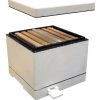TooBee...
Field Bee
- Joined
- Aug 11, 2017
- Messages
- 583
- Reaction score
- 2
- Location
- Ireland
- Hive Type
- National
- Number of Hives
- 2+ nucs
Happy New Year to everyone!
I was reading this Thread about increasing your colony numbers,
https://www.beekeepingforum.co.uk/showthread.php?t=38472
the suggestion is made in Message #25 to modify a Brood box.
So my question is this;
is there a reason why we make Nucs (to enlarge our apiaries, not for sale) in individual Nuc Boxes, and not just modify a Brood Box to house the two Nucs in at the end of the year, by adding an extra entrance hole at one end and place a divider between the two mini colonies? This 'modified' Brood Box could then be turned back into a normal Brood Box by closing the extra entrance and removing the divider. Or am I missing something?
Also:
In this Thread about Queen Banking over winter,
https://www.beekeepingforum.co.uk/showthread.php?t=41296
this Article was linked to,
https://www.researchgate.net/public...e_climate_and_its_effect_on_queen_performance
which essentially said anything other than a Mini Mating Nuc or standard Nuc reduced the Queens chances of surviving the Winter considerably - which got me looking into Mini Mating Nucs sometimes also referred to as Apedia, which then caused me to ask myself a similar question to the one above.
Why Use Mini Mating Nucs, why not modify a standard Nuc or make a 'modified + modified' Brood Box? Mini Mating Nucs have different Frames (or Apedia do at least), if you took an eight Frame Brood Box, you could modify it to have four Mini Mating Nucs (two Frames each) with an entrance on each side.
My two questions / suggestions would reduce the different types of boxes and frames that we use and need, surely making things much simpler and cheaper for us; so what have I missed, why don't we do this?
Apologies in advance for my ignorance if the answers should be obvious.
I was reading this Thread about increasing your colony numbers,
https://www.beekeepingforum.co.uk/showthread.php?t=38472
the suggestion is made in Message #25 to modify a Brood box.
So my question is this;
is there a reason why we make Nucs (to enlarge our apiaries, not for sale) in individual Nuc Boxes, and not just modify a Brood Box to house the two Nucs in at the end of the year, by adding an extra entrance hole at one end and place a divider between the two mini colonies? This 'modified' Brood Box could then be turned back into a normal Brood Box by closing the extra entrance and removing the divider. Or am I missing something?
Also:
In this Thread about Queen Banking over winter,
https://www.beekeepingforum.co.uk/showthread.php?t=41296
this Article was linked to,
https://www.researchgate.net/public...e_climate_and_its_effect_on_queen_performance
which essentially said anything other than a Mini Mating Nuc or standard Nuc reduced the Queens chances of surviving the Winter considerably - which got me looking into Mini Mating Nucs sometimes also referred to as Apedia, which then caused me to ask myself a similar question to the one above.
Why Use Mini Mating Nucs, why not modify a standard Nuc or make a 'modified + modified' Brood Box? Mini Mating Nucs have different Frames (or Apedia do at least), if you took an eight Frame Brood Box, you could modify it to have four Mini Mating Nucs (two Frames each) with an entrance on each side.
My two questions / suggestions would reduce the different types of boxes and frames that we use and need, surely making things much simpler and cheaper for us; so what have I missed, why don't we do this?
Apologies in advance for my ignorance if the answers should be obvious.
















































